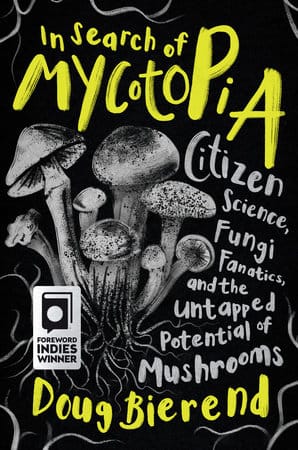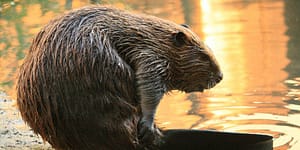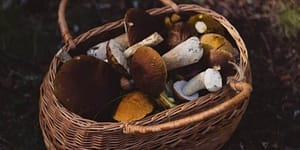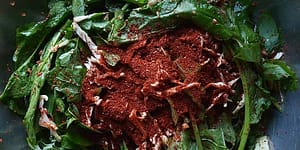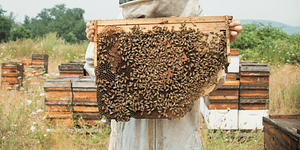So You Want to Be a Mycologist
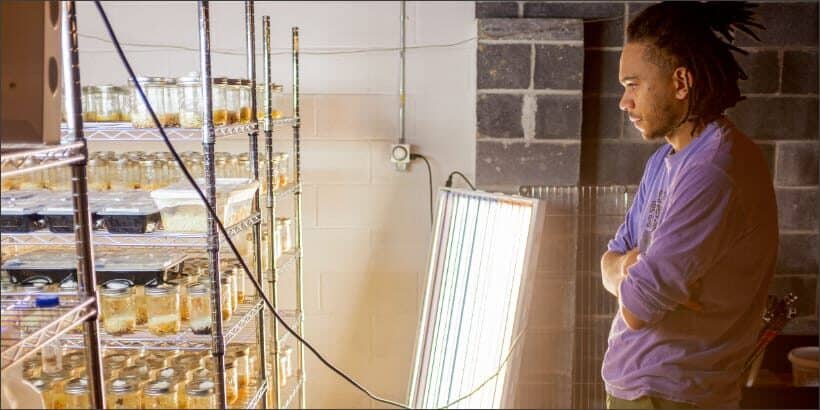
Due to the wave of ‘mycophelia’ occurring in North America, educational workshops that cover the basics of mushroom and fungal life are not hard to come by. In his book In Search of Mycotopia, author Doug Bierend takes the reader and aspiring mycologist with him to one of his first mycology classes – filled with slide show material, sweet-smelling bags of fungus, and cardboard spring rolls.
The following is an excerpt from In Search of Mycotopia by Doug Bierend. It has been adapted for the web.
(Photography curtesy of Doug Bierend.)
After crossing a rain-slicked street in downtown Brooklyn, I ducked under the awning of 33 Flatbush Avenue. The century-old former bank had gone decades since its last renovation, so the broken buzzer was hardly a surprise. As I dialed the number scrawled on a taped-up sheet of paper, someone on their way out let me sidle through the door, into the dim lobby and up the stairs. (The elevator was out of order, too.)
Nearing the fourth floor, I narrowly avoided colliding with Craig Trester as he rushed in the opposite direction. In addition to leading the night’s mycology class at Biotech Without Borders, it was his task to fetch each new arrival from the front door. After a hurried greeting, we passed through a long, unlit hallway flanked by dark, messy workspaces and the half-visible fragments of artworks-in-progress. Under the ownership of an eccentric old-timer named Al Attara, the seven-story Metropolitan Exchange—MeX, for short—had since the late 1970s played host to shifting casts of creatives, makers, citizen scientists, and offbeat entrepreneurs.1 It was a space with sufficient purpose and community feeling to have resisted the insistent force of gentrification. “This place is one of the last little chunks of old New York,” said Trester as we stepped into a brightly lit, cement-floored room where the class was to be held.

Photo curtesy of Doug Bierend.
Office chairs lined the length of a steel table, with a flat-screen TV set across from a comfy sofa and an impressive communal library. Despite the slight vibe of a basement den, it was really the classroom space for a community biology lab. Farther on, a Biosafety Level 1 lab space, certified to handle low-risk microbes, with a door that led to a self-contained room rated for Biosafety Level 2, allowing for working with “mammalian tissue cultures,” as Trester explained it.
Atop nearly every surface sat glassware, centrifuges, freezers, thermocyclers, all bought at auction or donated. Just days after our class, Biotech Without Borders would acquire a scanning electron microscope, hauled in the back of a rented truck from a plant genetics lab on Long Island. With limited resources, BWB had managed to bricolage an impressive capacity for far more meaningful science projects than merely creating multicolored flames from Bunsen burners or goading foam to erupt from beakers. One of their favorite experiments, for example, involved modifying the genes of algae to fluoresce under ultraviolet light.
“Before 2008, there were no community biology labs,” said Trester, introducing the facilities to our group as we settled in and shook off the December drizzle. “On the back of the financial collapse, a lot of biotech startup companies went belly-up, so all this biotechnology equipment you see went on the auction market.”
Trester’s presentation for the evening was evocatively titled “Fungi Are the Future: How Mushrooms Will Save Our World,” a nod to the popular TED talk by Paul Stamets, which was part of the inspiration for Trester to pursue his path of fascination with fungi.
The intention of the class was to guide the small but enthusiastic group of neophytes down the first steps of that same path.
Earnest and energetic, Trester was possessed of an enthusiasm for science that clearly took some effort to contain, expressing itself in staccato signals of constant information as he loped among scientific subjects and domains. The enthusiasm might have been due in part to his self-avowed caffeine addiction, but fungi had also presented a uniquely exciting subject.
At Trester’s behest, everyone around the table introduced themselves while he dashed downstairs once more. Among the eight attendees was a former publisher, the owner of an herbal medicine store, a vegan chef, a fashion designer. Almost everyone was in the early stages of their study of fungi. When Trester returned, he assumed his station next to the computer monitor, powered up the slideshow, and got under way. “I’m going to start with a presentation,” he said in a cheery baritone, tugging unconsciously at his wiry beard. “It’s going to have a lot of information.”

A photo of mycelia growing on a tree trunk. Photo curtesy of Danny Newman via ‘Colossal’.
The slideshow began with a photo of a chunk of asphalt, every centimeter of it threaded through by mycelia. Trester had taken the picture at a mycoremediation workshop at Van Cortlandt Park in the Bronx, and as of that moment, he recalled, “I became hooked and read as much material about the topic as I could find.” Skipping around the two-hundred-odd slides in his presentation, he led us through a horizon-spanning survey of fungal biology, ecology, and evolution. In video shot through a high-magnification microscope, we watched hyphae branch and grow as illuminated nuclei coursed throughout their length. Another video demonstrated the fusing of intersecting hyphae, in a process called anastomosis. Our session would cover only a fraction of all the material Trester had organized. Every raised hand presented a question that he pursued with gusto, exploding any structure the class may have once had into an improvised tangle of tangents and sidebars.
Trester seemed at times on the verge of losing some people, as molecular diagrams of organic polymers flicked across the screen, but no one complained; the presentation, scheduled to last for three hours, stretched out to five. There was just so much to cover, and Trester was evidently still working out how best to organize it all for a mixed audience. To get everyone on the same page, he held a bag of mycelium-infused grains over his head at the outset and announced: “This is fungus.” Then he cut open the top and passed it around the room, encouraging the room to take a whiff of the spawn, with its strangely pleasant, sweet aroma.
Over the preceding year, Trester, whose formal education is in history and political science, had succeeded in forging his interest for biology and biotechnology into an enthusiastic, multifarious career that had allowed for studying, practicing, and teaching the subjects that most fascinated him. Still in his twenties, he’d spent the previous three years working as a barista, bartender, and tutor of Chinese, until his scientific interests drove him to recognize a growing bioeconomy, in which he saw opportunity to support himself by educating people about fungi and the broader complexities of soil biology. Becoming an instructor with Biotech Without Borders and Genspace—the city’s predominant community biology labs, both housed at MeX—he pursued his own mycological research in parallel. Trester had managed to sustain his budding career by way of a constantly growing personal network, even teaching sessions in the city’s public schools with the support of the National Wildlife Federation and the Department of Education, developing mycology and soil ecology curricula for the city’s magnet schools. “It’s a pretty unique situation,” he told me.
But Trester is not alone in plying passion for mycology into a career outside academia.
Educational workshops like the one he taught were staples of an emerging culture around fungi in North America, an informal initiation that most modern mycophiles undertake in some form or another. Upon mastering the fungal foundations in these courses, many, like Trester, go on to teach their own versions. No matter where you catch one of these informational boot camps, or from whom, they often strike many of the same notes: the basic structure and life cycles of fungi, their ecological roles, their many uses and cultural associations. There is no official fungal pedagogy in this emerging world of citizen mycology, but rather a common vernacular aimed at familiarization with fungi and their many facets, the basics of growing mushrooms for food and medicine, taxonomy and identification, cloning and tissue culture, experiments with soil remediation and biomaterials.
Visual, tangible, even sniffable aids are standard fare. As the young educator spoke, his audience passed around mushrooms that had been strewn about the tabletop. Oftentimes, spawn or grow bags, petri dishes or jars containing fungal cultures, anything that can help to connect the information to the senses will also make the rounds.

Everyone was encouraged to return home with their spring roll–sized tubes, sweaty inside their plastic sandwich bags, to watch in the coming days as they became carpeted with fluffy white mycelia, hungry for more substrate. What would be done with the burritos after that was an open question. They might become the start of an at-home cardboard-composting project, digesting the cardboard or other refuse and eventually giving birth to edible mushrooms, assuming the absence of potentially toxic ink. With some patience and care, the inoculated wraps could be worked up into the basis of a small mushroom farm. Most, though, would probably end up tossed away, in which case, they represented at least some small amount of mitigated waste as the fungus digested the cardboard. No matter what, the students had made contact with a vast kingdom of life that many never experience beyond the borders of their dinner plate. Like the burritos themselves, the hope was that the students would become vectors for fungi, carrying on and sharing their newfound knowledge of and curiosity for the subject. It was all part of a process of demystification that each person could carry on in their own networks, to spread the proverbial spores.
“The cool thing about science is basically that you should be able to reproduce any good experiment,” said Trester to the class. “And that’s kind of the big goal here, to give you the access, and the tools to do so.”
Notes
- Jed Lipinski, “On Flatbush Avenue, Seven Stories Full of Ideas,” New York Times, January 11, 2011, https://www.nytimes.com/2011/01/12/realestate/commercial/12incubate.html.
https://www.chelseagreen.com/2021/how-to-grow-oyster-mushrooms-indoors/
Recent Articles
Beavers are ecological and hydrological Swiss Army knives. Capable of tackling just about any landscape-scale problem you might confront.
Read MoreWhen you’re walking around the grocery store looking at the vegetables, it’s probably hard to imagine that a century ago there was twice the amount of options.
Read MoreFor people who enjoy foraging for food in the wild, there are plenty of mushrooms to choose from — “ten thousand mushroom species to be considered on the North American continent alone”. But foraging for mushrooms should never be thought of as a game of chance. You need to know all the clues when it comes to identifying…
Read MoreNeed a new twist on kimchi? Look no further than this wild green kimchi! Experiment with what you have, anything from the mustard family will work extremely well.
Read MoreFor all the beekeepers and future beekeepers out there, this one is for you! Your journey to successful beekeeping begins with constructing a suitable haven for honeybees, otherwise known as the bee hive. The following is an excerpt from Raising Resilient Bees by Eric and Joy McEwen. It has been adapted for the web. Bees…
Read More
